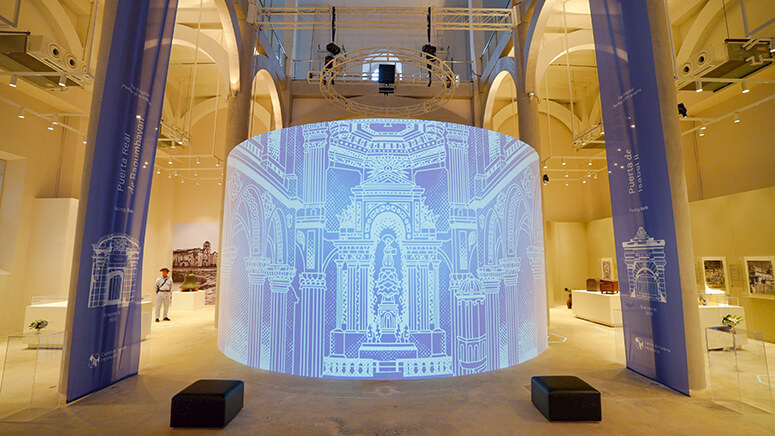Back to the future: The Centro de Turismo Intramuros opens
A new creative cauldron, the enchanting Centro de Turismo Intramuros, opened its doors recently, to the delight of Manila’s culture and history fans. Conceptualized by the First Lady Liza Araneta Marcos, the Center is intended to be a traveler’s very first portal to the Walled City, a nucleus that will give a glimpse of the Philippines’ historic past, its glittering present and its even brighter future.
Built on the foundations of the magnificent San Ignacio Church, the Center is a stunning combination, not only of contemporary art and interior architecture, but also videography and museum-quality exhibitions of objects such as a rare “baul mundo” and treasured saints. Encased in a jewel-like space, these elements breathe life into the once-forgotten ruin. This hyper-millennial outlook gives new meaning to Intramuros itself, foretelling how this city within a city can be transformed into a new identity.

The Center’s elegantly tall proportions set the stage for this futuristic setting. From the Center’s ceiling today hangs not iron candlelit chandeliers of the past but a gorgeous sculptural airship by cutting-edge artist Leeroy New. The artwork captures the vitality of Intramuros as the hub of the legendary Manila Galleon Trade—the very first instance of globalization, connecting Asia to Europe and the Americas. Leeroy New’s sculpture represents all that is global in the new Philippines—and sends a message that the Philippines is open for business.

Like the galleon sails first fashioned from Iloko abel, fine fabric scrims silkscreened with images from San Ignacio’s past are a gorgeous homage, bringing a sense of airiness and lightness of space. The Center is thus almost a surreal confection of stone and gossamer.

This audacious enterprise was put together at breakneck speed—from concept to final finishing. Indeed, it took a village of designers and heritage experts working as a tightly-knit team. The Philippine Institute of Interior Design headed by Paolo Castro, Cyndi Fernandez- Beltran, Cecile Ravelas, Mary Ann Bulanad and architect Nikki Tayag all pulled together with top-notch designer Jonathan Matti. They were called upon to put the place together in just 60 days; and they worked together with the historical team of Eric Zerrudo, Al Valenciano, Mico Manalo and Hannah Cunanan. In tandem with the Intramuros Administration headed by Atty. Joan Padilla, the project was finished in record time.

For Matti, who was a discreet presence toiling on the sidelines, the use of contemporary art and architecture can revitalize a city. His philosophy is that design plays a crucial role in shaping the way we live work, play and interact with our surroundings.
Atty. Padilla described the enterprise as the embodiment of the ideals of San Ignacio (or St. Ignatius) who championed education and exploration. “This center is not just a place to visit; it is a gateway to understanding and appreciating our rich past and the dynamic possibilities of our future. We see this center opening up new opportunities for Intramuros as a prime tourism destination,” she said. (The project came to fruition with the help of the Office of the President, the Office of the First Lady and the Department of Tourism.)
On the face of it, the Center is simply a starting point for tourists looking to ease their way into Old Manila’s richly layered past, from its 300 years in a Catholic convent to just 50 years in an American Hollywood. It encapsulates that history with wall-sized, moving maps of the old city’s streets and the church’s graceful arches and a well-thought out chronology of Intramuros from its pre-colonial days through the Second World War to the present. The sum total is an adaptive—and inventive—reuse of the original space. The possibilities for the interiors are unlimited: there is an amphitheater-style space for theatrical shows and immersive experiences, another cupola-ceilinged area with projectors, and various halls. (One can hardly wait to see what lies ahead for the exteriors.)
The Center is very much a bold statement of intent. At the launch, the First Lady declared, “Intramuros, with its storied walls and timeless streets, has always been a symbol of our resilience as a people. This center will add a new chapter to our legacy. It will house invaluable artifacts, tell the stories of our ancestors, and offer a space for learning, reflection and inspiration.
“It thus comes with the hope,” the First Lady added, “that it will foster a deeper understanding of our past and ignite a passion for preserving our cultural treasures. The Intramuros Tourist Center symbolizes our gateway to the past. It’s a celebration of our rich history and a testament to our collective identity.”


